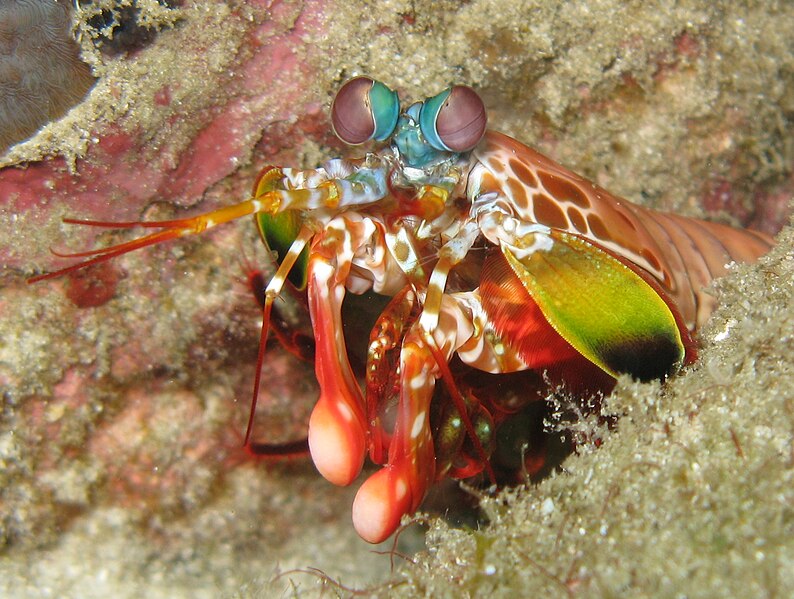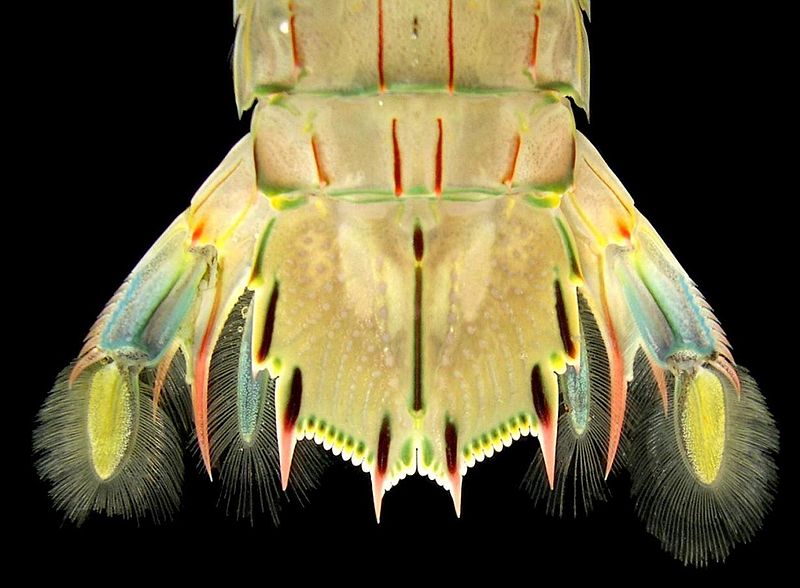 No matter the profession, everyone has favorite parts of their jobs. One of my favorite “duties” is identifying the livestock we get into our store. Although we used to only offer them as “assorted” individuals, we recently started identifying the Mantis Shrimp we get in whenever possible and they’ve become my new favorite subjects!
No matter the profession, everyone has favorite parts of their jobs. One of my favorite “duties” is identifying the livestock we get into our store. Although we used to only offer them as “assorted” individuals, we recently started identifying the Mantis Shrimp we get in whenever possible and they’ve become my new favorite subjects!
Mantis shrimp offer some of the most varied coloration of all the marine animals that enter the hobby. The same species can have a seemingly unlimited array of color schemes depending on where they were collected, gender, surrounding habitat, and a number of other factors. Knowing what to look at as the characteristic and consistent traits is key. Sometimes, especially when they are small, it can be difficult to inspect these aspects without getting closer to the shrimp than you may like or without examining a molt or dead shrimp. Many of the available references use rather technical anatomy terms that may not be easy to understand. Here are some terms that are helpful to know and parts of the shrimp that are helpful to look at when trying to identify a mantis shrimp:
- Raptorial Appendage: This refers to the most notorious part of a mantis shrimp, the “weapons”. The second pair of legs from the front are modified to use as a spear or, more commonly in our aquarium mantises, a crushing hammer. The strike is even faster than their namesake insect’s, and takes only the fraction of the time of a blink of the eye. The force of a smasher’s strike has been compared to the power of a gunshot.
- Meral Spot: The meral spot is often the last thing some unlucky prey will see. It is a false eyespot on the inside “elbow” of the raptorial appendage, thought to be a lure to attract prey or a warning to invaders before the mantis strikes. The color (or colors) of this spot can be the difference between two otherwise identical species.
- Antennal Scales: These are the pair of large, flat teardrop-shaped scales by the mantis’s eyes. Like the meral spot, the color of the antennal scales can help identify a species. For the mantis, these scales may be used in communication between shrimp – they are polarized and through a special lens, researchers have witnessed the shrimp displaying flashes of color with these scales.
- Eyes and Antennae: These are pretty recognizeable parts, but noting their color can help in identification. Some species of mantis shrimp also have very distinctive eyes. The eyes mantis shrimp are some of the most complex in the animal kingdom – certainly way more so than our own – but some species may be especially noteable with divided colors, star-like patterns or other features.
- Carapace: The carapace is the front of the shrimp’s body, the fused part before the articulated segments of the abdomen. It covers the upper head and the thorax, acting like armor and protecting it from damage and attacks. The pattern on the carapace can be distinctive – The Peacock Mantis Shrimp (Odontodactylus scyllarus), one of the most popular aquarium species, has large spots on the corner of the carapace which add to it’s appeal.
- Abdomen: The abdomen makes up most of the length of the mantis. It is broken up into articulated segments. This helps with locomotion and allows the shrimp to curl up for mobility and protection. The top of each segment is known as a tergite and the sides are known as pleurites.
- The Pods: Collectively, these are all the little appendages beneath the carapace and abdomen. Individually, from front to back, they include the maxillipeds (legs for walking and hunting), the pereiopods (also for walking but also used for conveying food towards the mandibles), the pleopods (the “swimmerets” used for breathing and swimming), and the uropods (on the tail, polarized like the antennal scales and possibly used for communication and movement). They can be the same color as the rest of the body or highly contrasting in color, depending on the species or gender of the mantis.
- Telson: The telson is the spiny end “flap” on the body. They use it to some extent in locomotion, but also as a sort of trapdoor to protect themselves; some will close their burrow at night by covering the opening with the telson. The carinae (singular = carinule) are small slit-like openings on the telson; often they are not visible on live mantis although they can be the tell-tale characteristic between some species.
Some people look at mantis shrimp as nuisance invaders; others view them as fascinating specialty “pets” for a species-only aquarium. I view them as a challenge. If you have a mantis you’d like to try to ID, make a list of as many of the characteristics you can see and start searching. I like Roy’s List of Stomatopods for the Aquarium a website by Roy Caldwell, biologist with UC Berkeley widely considered to be one of the foremost experts in Stomatopod research, identification and care. Most of the common species offered in the trade are covered, along with a lot of other really cool ones we will probably never see!
Thanks,
Eileen
Peacock Mantis Shrimp off the coast of Thailand image referenced from wikipedia and originally posted by Silke Baron
 That Fish Blog – Aquarium Advice and Information
That Fish Blog – Aquarium Advice and Information



